Discover 35 hidden attractions, cool sights, and unusual things to do in Durham (United States). Don't miss out on these must-see attractions: Durham Bulls Athletic Park, Sarah P. Duke Gardens, and Durham Athletic Park. Also, be sure to include Duke Chapel in your itinerary.
Below, you can find the list of the most amazing places you should visit in Durham (North Carolina).
Table of Contents
Durham Bulls Athletic Park
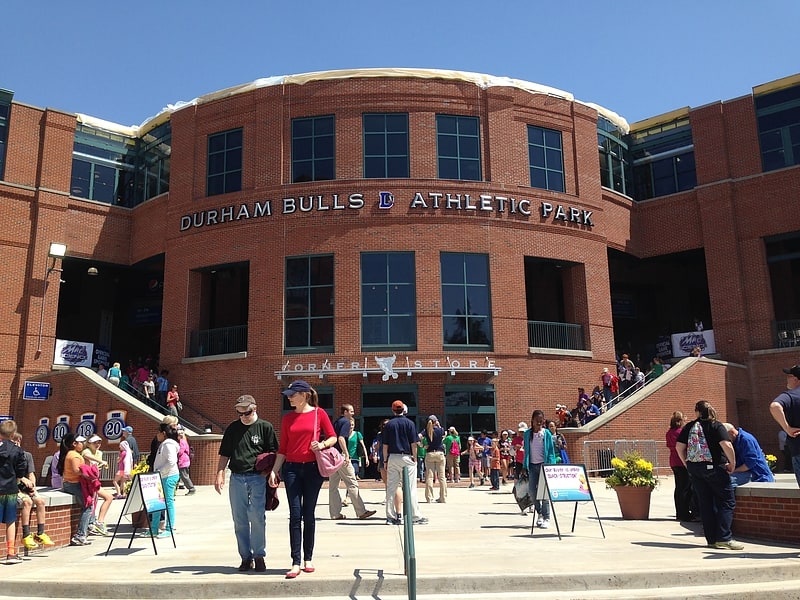
Ballpark in Durham, North Carolina. Durham Bulls Athletic Park is a 10,000-seat ballpark in Durham, North Carolina that is home to the Durham Bulls, the Triple-A affiliate of the Tampa Bay Rays of Major League Baseball. It is also home to the Duke Blue Devils and North Carolina Central Eagles college baseball teams. The $18.5-million park opened in 1995 as the successor to the Durham Athletic Park.[1]
Address: 409 Blackwell St, 27701-3972 Durham
Sarah P. Duke Gardens
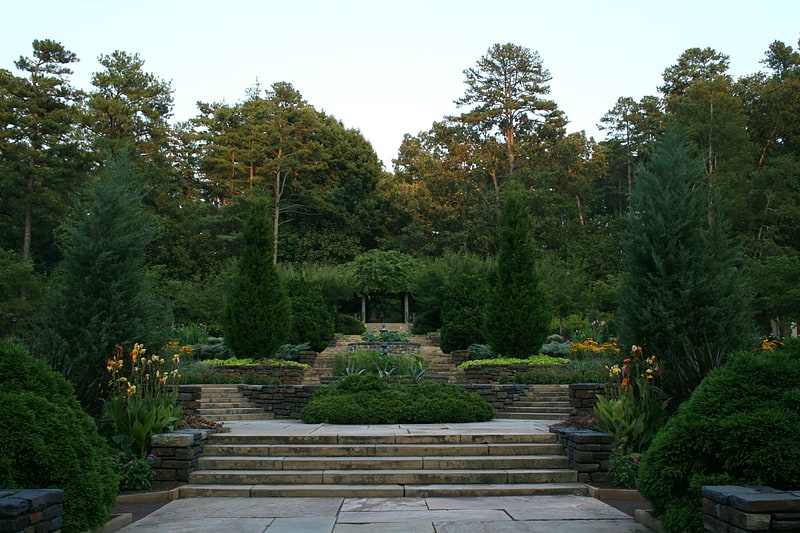
Botanical garden in Durham, North Carolina. The Sarah P. Duke Gardens consist of approximately 55 acres of landscaped and wooded areas at Duke University located in Durham, North Carolina. There are 5 miles of allées, walks, and pathways throughout the gardens. The gardens are divided into four areas, the Historic Core and Terraces, the H.L Blomquist Garden of Native Plants, the William Louis Culberson Asiatic Arboretum and the Doris Duke Center Gardens. The gardens are a memorial to Sarah Pearson Angier Duke, mother of Mary Duke Biddle and wife of Benjamin N. Duke, one of Duke University's benefactors.[2]
Address: 426 Anderson St, 27708-0341 Durham
Durham Athletic Park
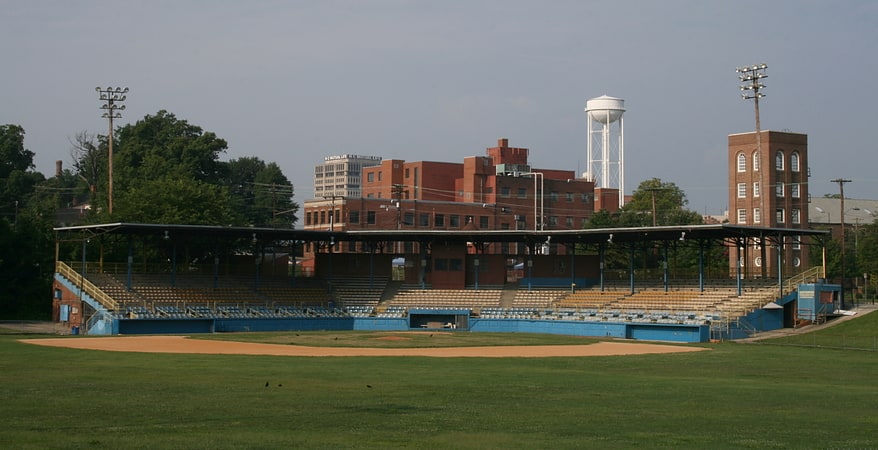
Stadium in Durham, North Carolina. Durham Athletic Park, nicknamed "The DAP", is a former minor league baseball stadium in Durham, North Carolina. The stadium was home to the Durham Bulls from 1926 through 1994, and is currently home to the North Carolina Central Eagles and the Durham School of the Arts Bulldogs. The DAP sits north of the downtown area of Durham, on the block bounded by Washington, Corporation, Foster and Geer Streets.
Durham Athletic Park became one of the most famous minor league ballparks in history thanks to the 1988 film Bull Durham, featuring the Bulls, Kevin Costner, Tim Robbins and Susan Sarandon. Most of the filming was done at the DAP, following the end of the Carolina League season of 1987. The film's wide acclaim helped fuel the burgeoning public interest in minor league ball in general. In the case of both the city and the film, this explosion of popularity caused the DAP to become a victim of its own success; despite expansion with temporary bleachers, it was just too small to handle the increase in crowd size and the Bulls’ Triple-A ambitions.
The Bulls moved to their new home Durham Bulls Athletic Park (also known as the "DBAP") in downtown Durham, starting with the 1995 season. Durham Bulls Athletic Park was built with a capacity to Carolina League standards, but the land that the DBAP was built on had more room in case the ballpark needed to be expanded for Triple-A baseball. Triple-A baseball came to Durham in 1998 and the Bulls moved up from High-A to Triple-A, with the DBAP then expanded to Triple-A standards.[3]
Address: 500 W Corporation St, 27701 Durham
Duke Chapel
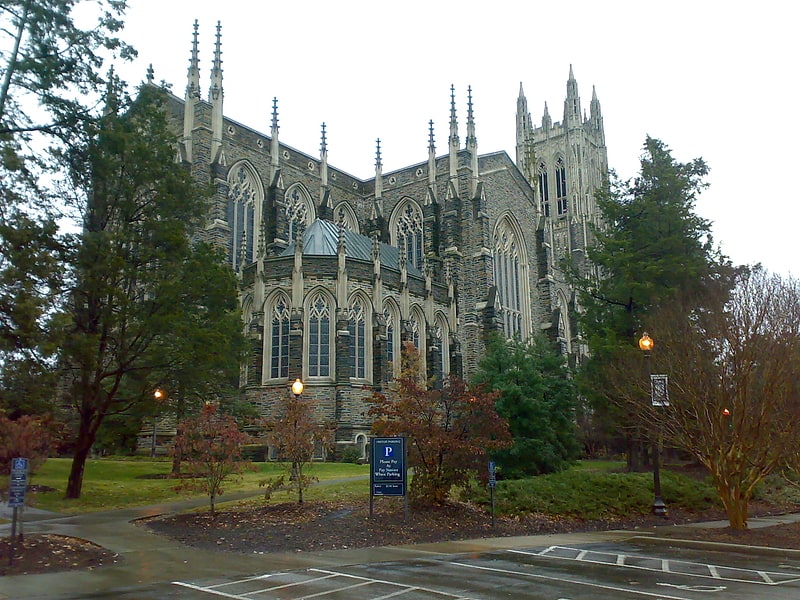
Chapel in Durham, North Carolina. Duke University Chapel is a chapel located at the center of the campus of Duke University in Durham, North Carolina, United States. It is an ecumenical Christian chapel and the center of religion at Duke, and has connections to the United Methodist Church. Constructed from 1930 to 1932, the Chapel seats about 1,800 people and stands 210 feet tall, making it one of the tallest buildings in Durham County. It is built in the Collegiate Gothic style, characterized by its large stones, pointed arches, and ribbed vaults. It has a 50-bell carillon and three pipe organs, one with 5,033 pipes and another with 6,900 pipes.
The Chapel stands at the center of the university, on the highest ridge of Duke University's West Campus. Although plans for a chapel were first made in April 1925, the cornerstone was not laid until October 22, 1930. When it was completed in 1935 at a cost of $2.3 million, the Chapel was the last of the original buildings to be built on West Campus. It was first used during Commencement in 1932, and was formally dedicated on June 2, 1935. Stained-glass windows and other details were installed at a later date. The chapel was designed by Julian Abele, a noted African-American architect who designed much of Duke's west campus and who was also chief designer for the Philadelphia firm of Horace Trumbauer.
As of 2015, the dean of the Chapel is the Rev. Dr. Luke A. Powery. On May 11, 2015 the Chapel closed for a year due to necessary restoration work on the ceiling. The Chapel reopened May 11, 2016.[4]
Address: 401 Chapel Dr, 27708 Durham
Bennett Place
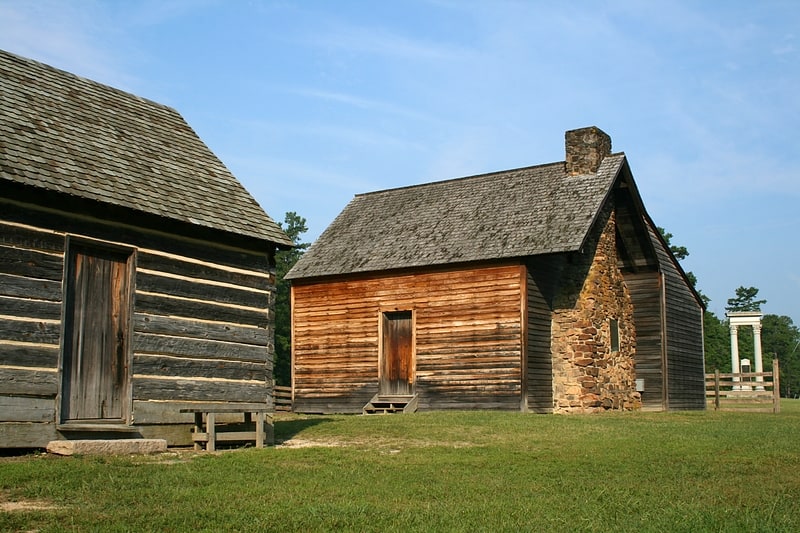
Historical landmark in Durham, North Carolina. Bennett Place is a former farm and homestead in Durham, North Carolina, which was the site of the last surrender of a major Confederate army in the American Civil War, when Joseph E. Johnston surrendered to William T. Sherman. The first meeting saw Sherman agreeing to certain political demands by the Confederates, which were promptly rejected by the Union cabinet in Washington. Another meeting had to be held to agree on military terms only, in line with Robert E. Lee’s recent surrender to Ulysses S. Grant. This effectively ended the war.[5]
Address: 4409 Bennett Memorial Rd, 27705-2307 Durham
Cameron Indoor Stadium
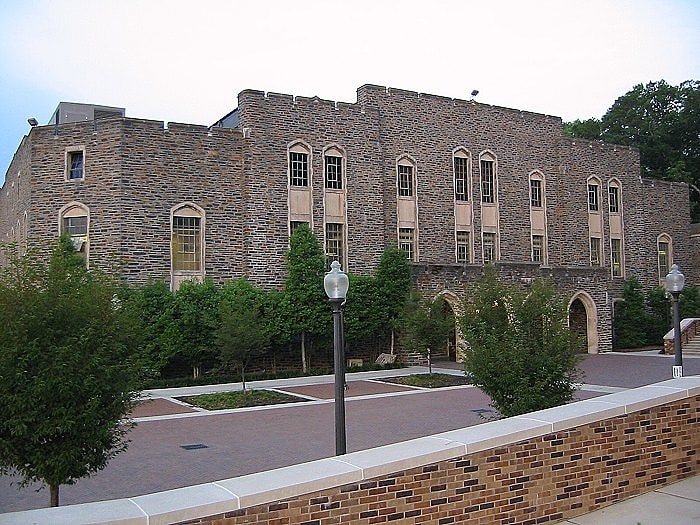
Arena in Durham, North Carolina. Cameron Indoor Stadium is an indoor arena located on the campus of Duke University in Durham, North Carolina. The 9,314-seat facility is the primary indoor athletic venue for the Duke Blue Devils and serves as the home court for Duke men's and women's basketball and women's volleyball. It opened in January 1940 and was known as Duke Indoor Stadium until 1972, when it was named for Eddie Cameron, who served at Duke as men's basketball coach from 1928 to 1942, football coach from 1942 to 1945, and athletic director from 1951 to 1972. The arena is located adjacent to its predecessor, Card Gymnasium, which opened in 1930.[6]
Address: 115 Whitford Dr, 27708 Durham
Levine Science Research Center

The Levine Science Research Center is a 341,000-square-foot facility on Duke University's west campus located at 308 Research Drive Durham, NC 27708. The LSRC is currently the largest single-site interdisciplinary research facility in the U.S. Its classrooms are shared by several departments, but the majority of its offices and laboratories are utilized by the Nicholas School of the Environment, the Pratt School of Engineering, the Center for Cognitive Neuroscience and Developmental and the departments of Computer Science, Pharmacology and Cancer Biology and Cell and Molecular Biology. The building was named for Leon Levine, the CEO of Family Dollar Stores.[7]
Wallace Wade Stadium
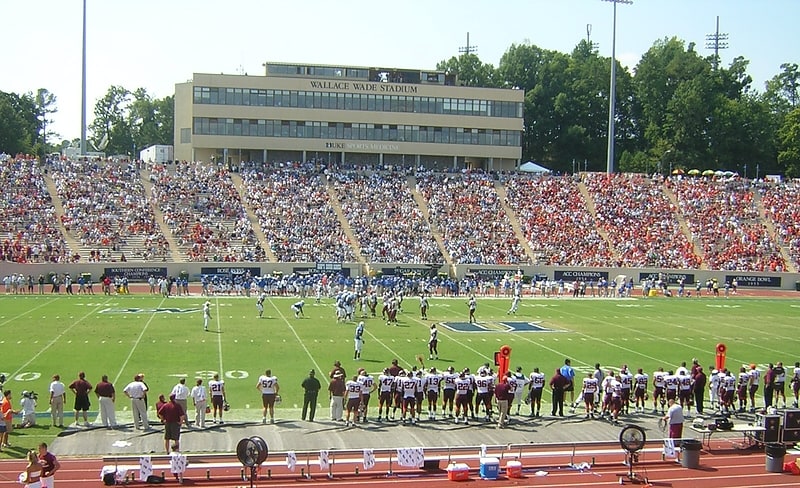
Stadium in Durham, North Carolina. Wallace Wade Stadium, in full Brooks Field at Wallace Wade Stadium, is a 40,004-seat outdoor stadium in the southeastern United States, located on the campus of Duke University in Durham, North Carolina. Primarily used for American football, it is the home field of the Duke Blue Devils of the Atlantic Coast Conference.
Opened 93 years ago in 1929, it was the first facility in Duke's new West Campus. Originally Duke Stadium, it was renamed in 1967 for former head coach Wallace Wade. The playing surface was renamed Brooks Field at the beginning of the 2015 season after the removal of the track and lowering of the field-level seats.[8]
Address: 110 Frank Basset DR, 27708-0001 Durham
Eno River State Park
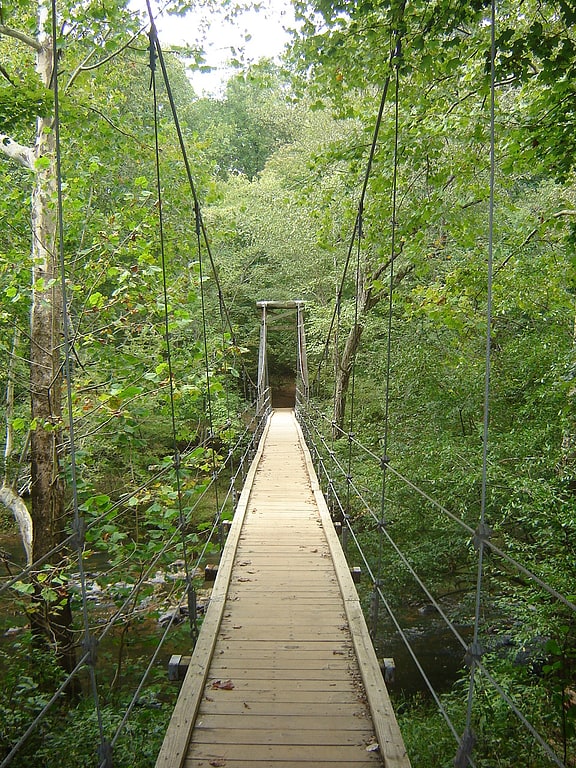
State park in North Carolina. Eno River State Park is a 4,319-acre North Carolina state park in Durham and Orange Counties, North Carolina. Together with the adjoining West Point on the Eno city park, the two parks preserve over 14 miles of the Eno River and surrounding lands.
There are five public access areas with features including twenty-four miles of hiking trails, canoe launches, picnic areas, and historic structures.[9]
Museum of Life and Science

The Museum of Life and Science—previously known as the North Carolina Museum of Life and Science and the NC Children's Museum—is an 84-acre science museum located in Durham, North Carolina, United States.
The museum exists in the midst the Northgate Park neighborhood, bisected by Murray Avenue. The main building is located on the north tract, along with the Butterfly House, Hideaway Woods, Farmyard, Sprout Cafe, Explore the Wild nature park, Catch the Wind, Dinosaur Trail, and the 2 ft narrow gauge Ellerbe Creek C.P. Huntington train ride. The Museum features both indoor and outdoor learning environments. The southern tract is now largely devoted to parking and administrative buildings, including a parking deck completed in early 2018. Prior to the construction of the new main building in the early 1990s, the structures on the southern tract contained the bulk of the museum's exhibit space.[10]
Address: 433 W Murray Ave, 27704 Durham
Carolina Theatre
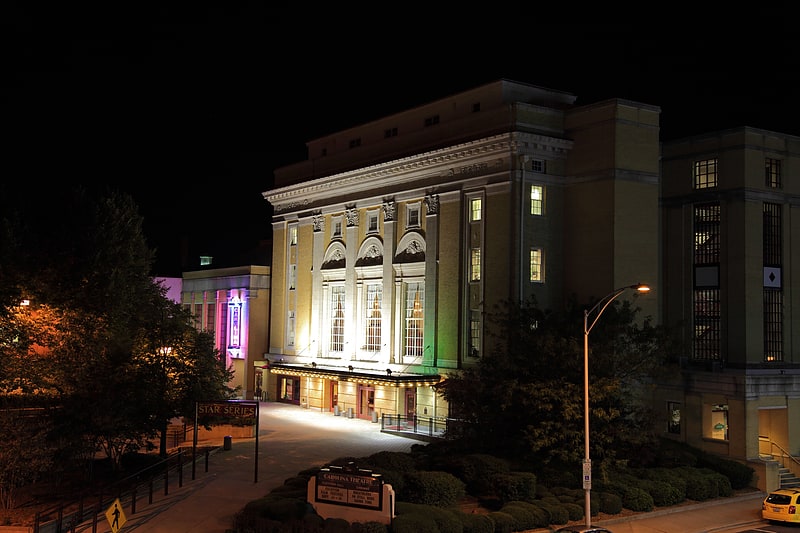
Theatre in Durham, North Carolina. Carolina Theatre could refer to:
- Carolina Theatre (Charlotte), a performing arts venue in Charlotte, North Carolina
- Carolina Theatre (Durham), a performing arts venue in Durham, North Carolina
- Carolina Theatre of Greensboro, a performing arts venue in Greensboro, North Carolina
- Carolina Theatre (Lumberton, North Carolina), a performing arts venue in Lumberton, North Carolina
Address: 309 W Morgan St, 27701-2119 Durham
Nasher Museum of Art

Museum in Durham, North Carolina. The Nasher Museum of Art is the art museum of Duke University, and is located on Duke's campus in Durham, North Carolina, United States. The Nasher, along with Dartmouth's Hood Museum of Art and Princeton's Art Museum, has been recognized as a place that "raises the cultural bar" on college campuses.[12]
Address: 2001 Campus Dr, 27705-1003 Durham
Durham Farmers' Market
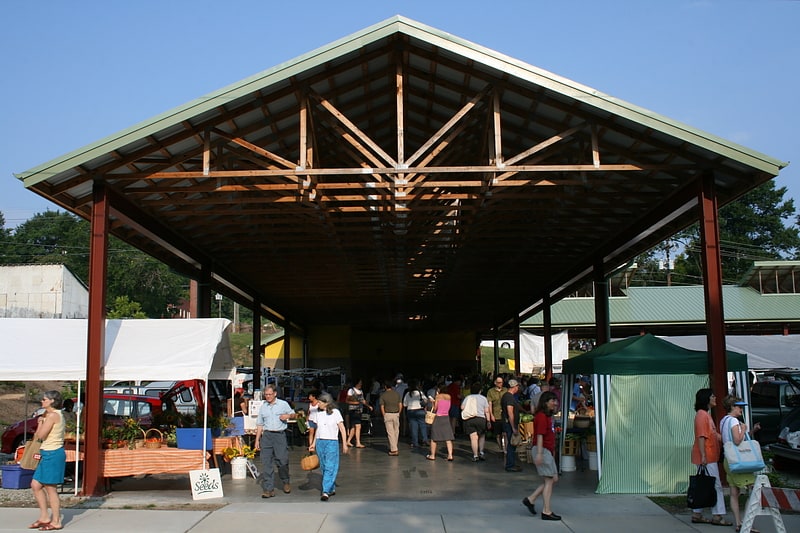
Farmers' market in Durham, North Carolina. The Durham Farmers' Market is a producer-only farmer's market located in Durham, North Carolina, established in 1998. As part of the Market's emphasis on locally produced produce, crafts and flowers, items sold by the Market's vendors are restricted to traveling no more than 70 miles on its journey to Durham.[13]
Address: 501 Foster St, 27701-2106 Durham
Falls Lake State Recreation Area
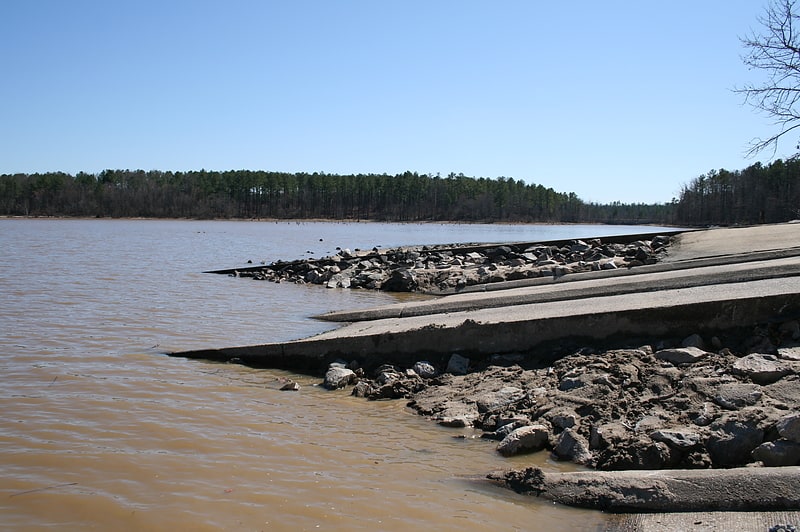
State park in North Carolina. Falls Lake State Recreation Area is a North Carolina state park in Durham and Wake Counties, North Carolina in the United States. Near Wake Forest, North Carolina, it covers 5,035 acres along the shores of 12,410-acre Falls Lake.[14]
Brightleaf Square
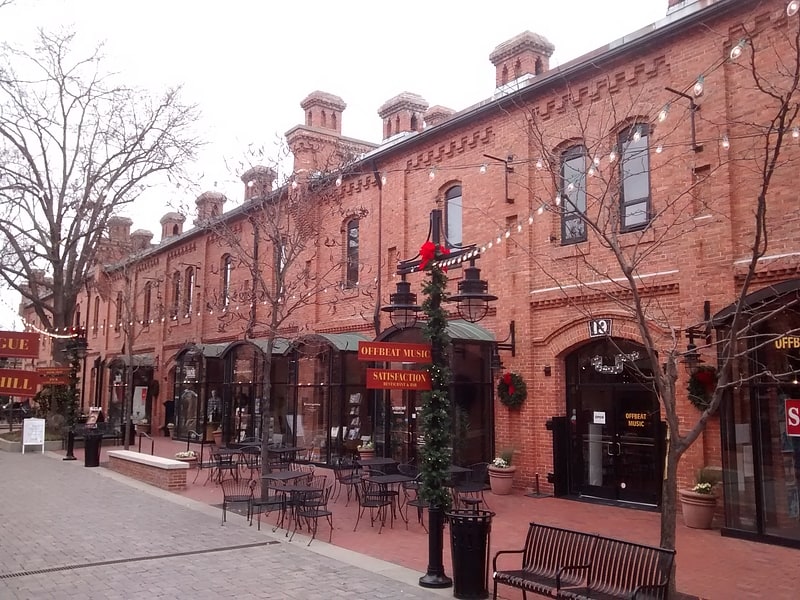
Watts and Yuille Warehouses, also known as Brightleaf Square, are two historic tobacco storage warehouses located at Durham, Durham County, North Carolina. They were built in 1904, and are two identical buildings parallel to each other with a courtyard in between. They are two-story Romanesque style brick structures, seven bays wide and twenty bays long. Each unit of the warehouses is 75 feet by 118 feet, for a total of 35,400 square feet on each floor. They are an example of "slow burn" masonry and wood factory construction. They were among the 12 brick tobacco storage warehouses erected by The American Tobacco Company trust beginning in 1897. The buildings have been converted to retail and office use.
It was listed on the National Register of Historic Places in 1984.[15]
Address: 905 W Main St, 27701-2054 Durham
Duke University
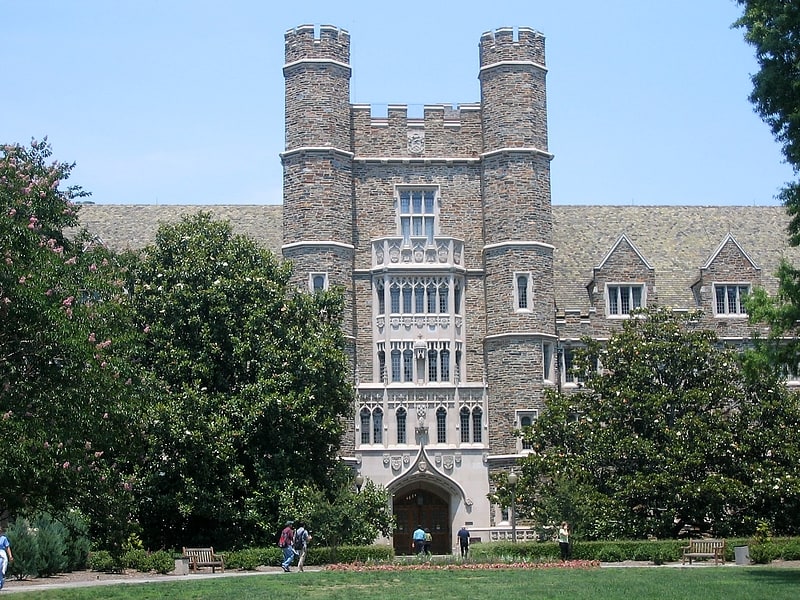
Private university in Durham, North Carolina. Duke University is a private research university in Durham, North Carolina. Founded by Methodists and Quakers in the present-day town of Trinity in 1838, the school moved to Durham in 1892. In 1924, tobacco and electric power industrialist James Buchanan Duke established The Duke Endowment and the institution changed its name to honor his deceased father, Washington Duke.
The campus spans over 8,600 acres (3,500 hectares) on three contiguous sub-campuses in Durham, and a marine lab in Beaufort. The West Campus—designed largely by architect Julian Abele, an African American architect who graduated first in his class at the University of Pennsylvania School of Design—incorporates Gothic architecture with the 210-foot (64-meter) Duke Chapel at the campus' center and highest point of elevation, is adjacent to the Medical Center. East Campus, 1.5 miles (2.4 kilometers) away, home to all first-years, contains Georgian-style architecture. The university administers two concurrent schools in Asia, Duke-NUS Medical School in Singapore (established in 2005) and Duke Kunshan University in Kunshan, China (established in 2013).
Duke is ranked among the top universities in the United States and in the world by major publications. The undergraduate admissions are among the most selective in the country, with an overall acceptance rate of 5.7% for the class of 2025. Duke spends more than $1 billion per year on research, making it one of the ten largest research universities in the United States. More than a dozen faculty regularly appear on annual lists of the world's most-cited researchers. As of 2019, 15 Nobel laureates and 3 Turing Award winners have been affiliated with the university. Duke alumni also include 50 Rhodes Scholars, the third highest number of Churchill Scholars of any university (behind Princeton and Harvard), and the fifth-highest number of Rhodes, Marshall, Truman, Goldwater, and Udall Scholars of any American university between 1986 and 2015. Duke is the alma mater of one president of the United States (Richard Nixon) and 14 living billionaires.
Duke is the second-largest private employer in North Carolina, with more than 39,000 employees. The university has been ranked as an excellent employer by several publications.[16]
West Point on the Eno
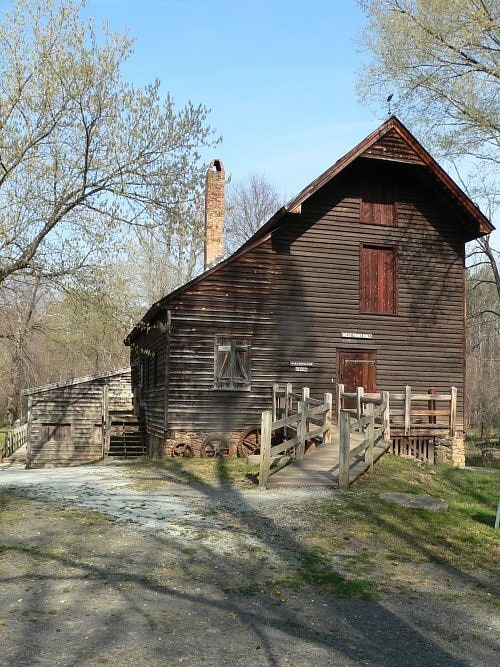
Park in Durham, North Carolina. West Point on the Eno is a city park and historical center covering 412 acres in Durham, Durham County, North Carolina.
Several historical structures are conserved on the site:
- West Point Mill - a reproduction colonial-era mill that is now a museum.
- Hugh Mangum Museum of Photography - located in the restored tobacco packhouse, features historic photographs from the late 19th and early 20th century from negatives found in the packhouse, also historic camera equipment
- McCown-Mangum House - home to one of the mill's owners, restored 1850s farmhouse with late 19th-century furnishings, open for tours
Other facilities include:
- Amphitheatre - includes a large open field, lawn seating, stage, electricity, water, parking
- 5 miles of trails
- Picnic facilities
- Canoe access to the Eno River
- Natural Play Space - a play area for children
Duke Homestead
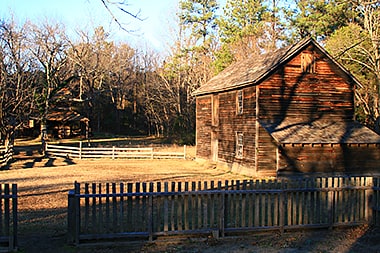
Historical place in Durham, North Carolina. Duke Homestead State Historic Site is a state historic site and National Historic Landmark in Durham, North Carolina. The site belongs to the North Carolina Department of Natural and Cultural resources and commemorates the place where Washington Duke founded the nation's largest early-20th-century tobacco firm, the American Tobacco Company.[18]
Address: 2828 Duke Homestead Rd, 27705-2726 Durham
Duke Memorial United Methodist Church
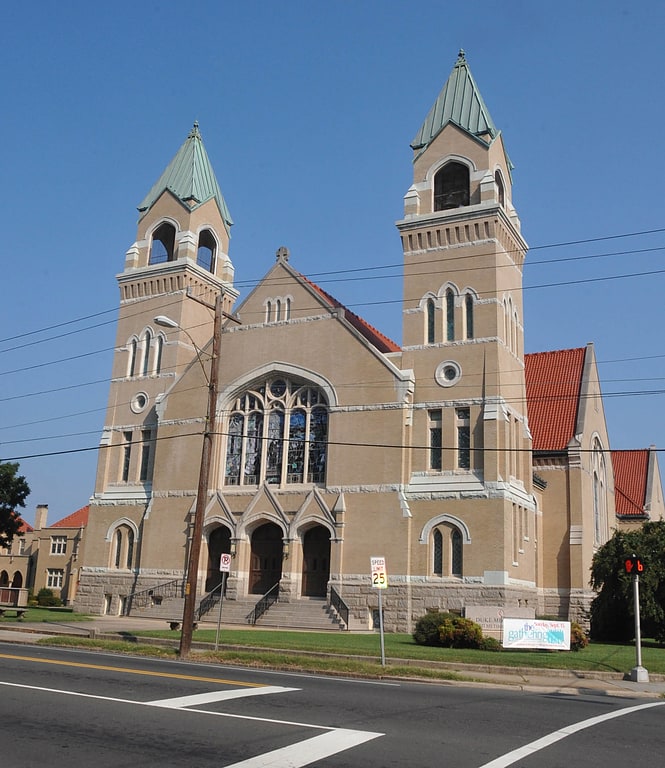
Building in Durham, North Carolina. Duke Memorial United Methodist Church is a historic Methodist church at 504 W. Chapel Hill Street in Durham, North Carolina. It was originally established in 1886. The congregation's growth paralleled Durham's growth as a manufacturing center in the textile and tobacco industries and has maintained a close connection with Duke University. From its beginning, the church has counted among its members many of Durham's educational and industrial elite. It is named in honor of tobacco magnate and philanthropist Washington Duke and his sons, who were instrumental in the building of the church.[19]
Address: 504 W Chapel Hill St, 27701-3102 Durham
Norfolk Southern–Gregson Street Overpass
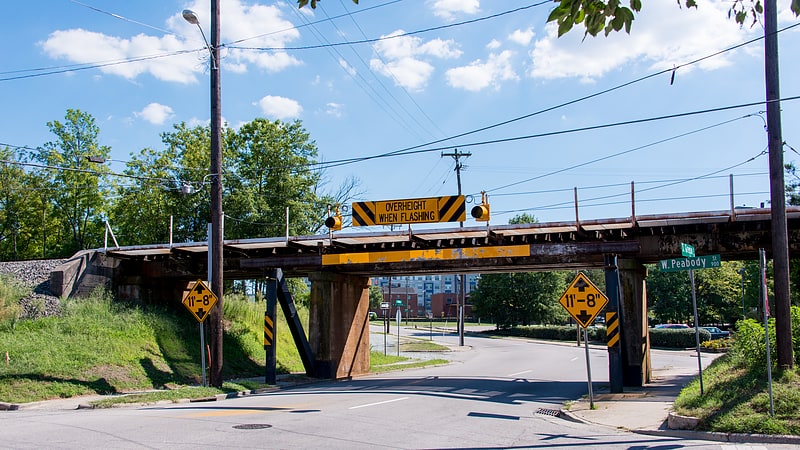
Beam bridge. The Norfolk Southern–Gregson Street Overpass is a railroad bridge in Durham, North Carolina, United States. The 82-year-old bridge allows passenger and freight trains to cross over South Gregson Street in downtown Durham.
The bridge was designed in the 1920s and built in 1940, with a clearance for vehicles of 11 feet 8 inches (3.56 m), the standard height at the time it opened. Since 1973, the standard clearance for bridges was increased to a minimum height of 14 feet (4.27 m), which is 2 feet 4 inches (0.71 m) higher than the bridge as built. Despite numerous warning signs about the low clearance, a large number of trucks, buses, and RVs have collided with the overpass at high speed, tearing off roof fixtures, and at times shearing off the trucks' roofs, earning the bridge the nicknames the "Can Opener" and the "Gregson Street Guillotine".
In October 2019, the North Carolina Railroad Company, which owns the bridge and tracks, raised the bridge by 8 inches (20 cm) to 12 feet 4 inches (3.76 m) to reduce collisions (although that is still well below the standard height of 14ft).
The bridge gained fame as a nearby office worker, Jürgen Henn, set up cameras in 2008 to track the collisions with the bridge. Henn has recorded over 100 collisions with the bridge, including those after the bridge raising, and the YouTube channel he set up to showcase his recordings has 226,000 subscribers and more than 71 million views. Despite the number of crashes, there have been only three injuries reported, making rebuilding of the bridge a low-priority concern.[20]
Durham Centre
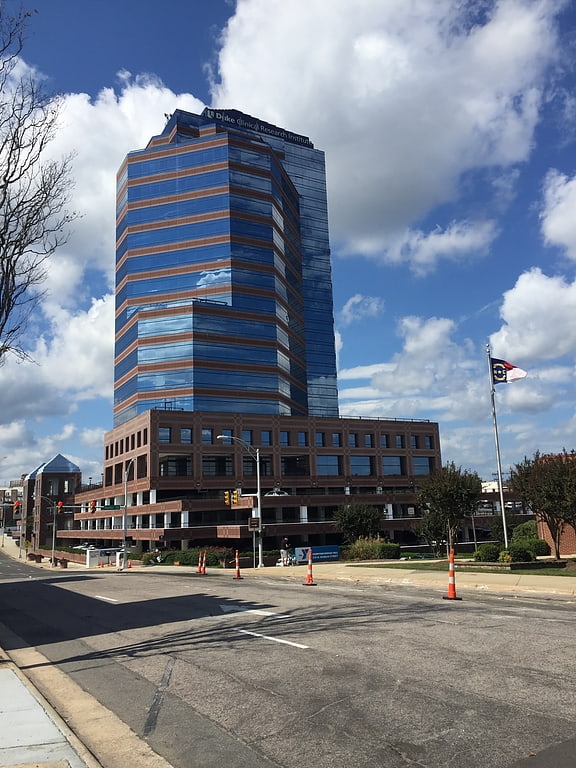
Building in Durham, North Carolina. The Durham Centre is a 15-story office skyscraper located at 300 West Morgan Street in Downtown Durham, North Carolina.
Durham Centre is the second tallest building in downtown Durham, after the One City Center, and the third tallest in Durham behind University Tower (standing at 350 feet 4 miles southwest of downtown).
Completed in 1988, it was originally named People's Security Tower after its original primary tenant, People's Security Insurance. It has three stories of garage parking,
The original plan called for a "twin tower" adjacent to Durham Centre that would be called "Renaissance at Durham Centre" and would comprise mainly of condominiums and apartments with retail on the lower levels. This project was cancelled and the plot where the building would have been has been turned into a small greenspace adjacent to Durham Centre on top of the parking garage.[21]
Durham Performing Arts Center
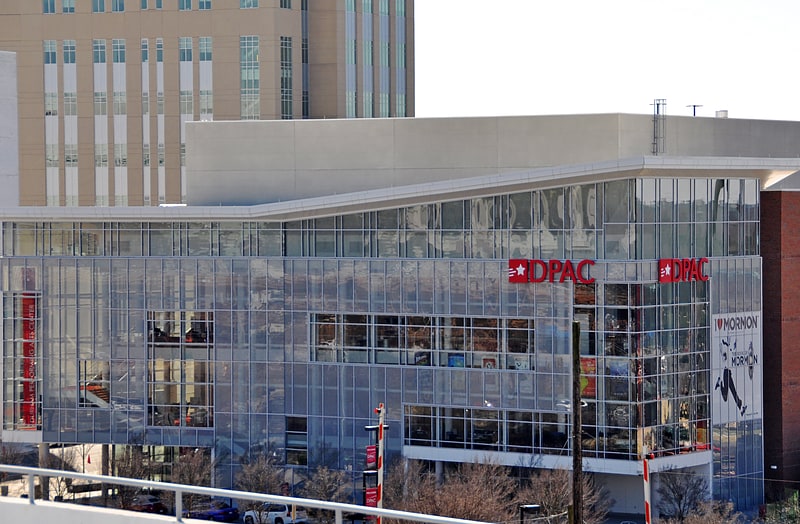
Theater in Durham, North Carolina. The Durham Performing Arts Center opened November 30, 2008 as the largest performing arts center in the Carolinas at a cost of $48 million. The DPAC hosts over 200 performances a year including touring Broadway productions, high-profile concert and comedy events, family shows and the American Dance Festival. Operated under the direction of Nederlander and Professional Facilities Managaement, DPAC has twice been listed as the #1 performing arts organization in the Triangle region by the Triangle Business Journal. Construction of the DPAC was part of a larger plan to redevelop downtown Durham by the Capitol Broadcasting Company, and includes other nearby properties such as the American Tobacco Historic District, the Durham Bulls Athletic Park, and the studios of the CBC-owned Fox 50 TV station.
Listed three times in the top 50 in Pollstar magazine's worldwide theater attendance ranking, in 2011 DPAC was the #1 U.S. Theater in the listing with a capacity under 4,000 and #4 ranked Theater among all U.S. Theaters. On August 16, 2016, the venue surpassed having 3 million visitors since its opening.[22]
Address: Durham, 123 Vivian Street
Durham Central Park
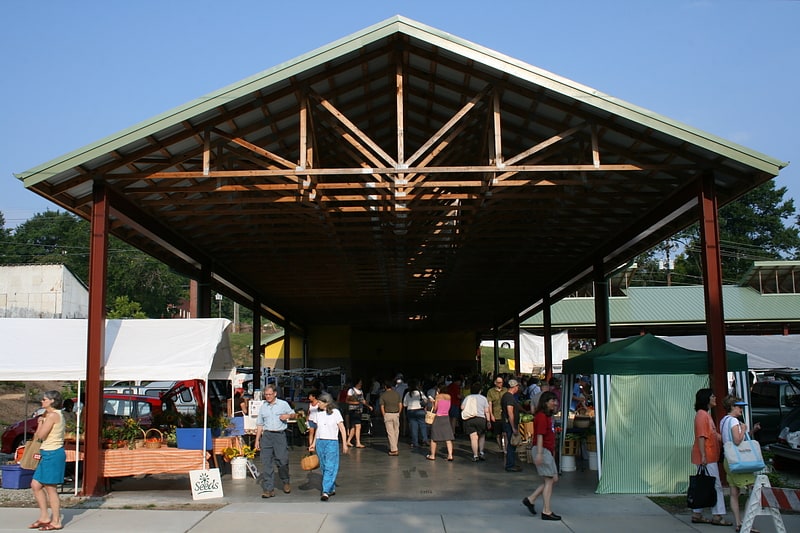
Park in Durham, North Carolina. Durham Central Park is an arts-themed, community-focused, municipal park in downtown Durham, North Carolina. It is located at 502 Foster Street, and is the site of the newly opened Pavilion at Durham Central Park which hosts the Durham Farmers' Market.[23]
Address: 501 Foster St, 27701-2106 Durham
Downtown Durham Historic District

Downtown Durham Historic District is a national historic district located at Durham, Durham County, North Carolina. The district encompasses 97 contributing buildings and 1 contributing structure in the central business district of Durham. The buildings primarily date from the first four decades of the 20th century and include notable examples of Colonial Revival, Italianate, and Art Deco architecture. Notable buildings include the St. Philip's Episcopal Church, Trinity Methodist Episcopal Church, First Baptist Church, Durham County Courthouse, Durham Auditorium, Tempest Building, National Guard Armory, United States Post Office, Trust Building, First National Bank Building, Mechanics and Farmers Bank, Johnson Motor Company showroom, Hill Building, Snow Building, and S. H. Kress store.
It was listed on the National Register of Historic Places in 1977.
On August 14, 2017 a 15-foot-high statue of an armed Confederate patriot was torn down in front of the 1916 Durham County Courthouse by demonstrators. The destruction of the statue followed the 2017 Unite the Right rally in Charlottesville, Virginia where one counter-demonstrator was killed.[24]
W. T. Blackwell and Company

W.T. Blackwell & Co. Tobacco was a tobacco manufacturer in Durham, North Carolina. It was best known as the original producer of Bull Durham Tobacco, the first nationally marketed brand of tobacco products in the United States. The Blackwell tobacco factory in Durham, built in 1874, was declared a National Historic Landmark in 1977. It is included in the American Tobacco Company Manufacturing Plant historic district, and is now occupied by apartments.[25]
Duke Divinity School
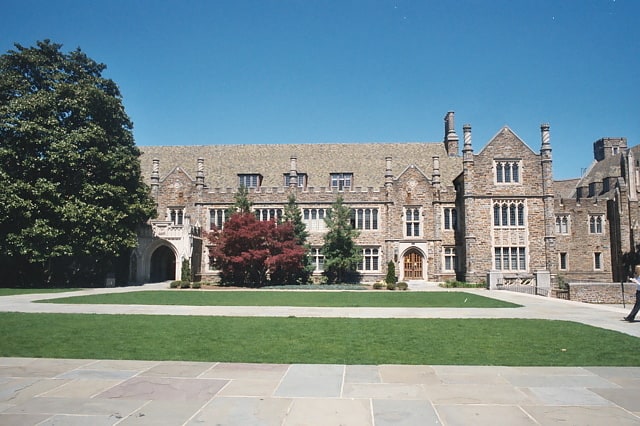
Seminary in Durham, North Carolina. The Divinity School at Duke University in Durham, North Carolina, is one of ten graduate or professional schools within Duke University. It is also one of thirteen seminaries founded and supported by the United Methodist Church. It has 39 regular rank faculty and 15 joint, secondary or adjunct faculty, and, as of 2017, an enrollment of 543 full-time equivalent students. The current dean of the Divinity School is the Rev. Dr. Edgardo Colón-Emeric, who assumed the deanship on Aug. 31, 2021. Former deans include the prominent New Testament scholar Richard B. Hays, who stepped down in 2015.[26]
Hill Building
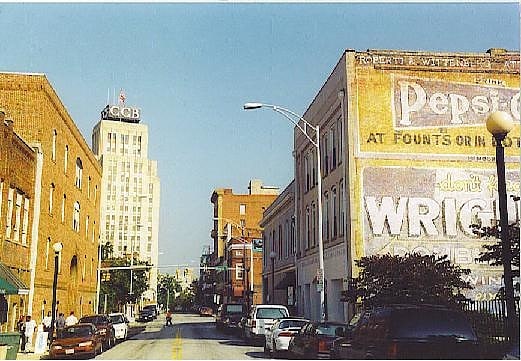
Skyscraper in Durham, North Carolina. The Hill Building is a 17-story modernistic skyscraper located in Durham, North Carolina. Built in 1935–1937, the Hill Building was designed by New York City architecture firm Shreve, Lamb & Harmon, best known for the design of the Empire State Building.
Named for John Sprunt Hill, and built to house the Durham Bank & Trust Company, the building is outfitted with Art Deco ornamentation, interior fluted doors and an exquisitely crafted letter box. The building is in the heart of downtown Durham, located at the intersection of Main and Corcoran Streets. The Hill building was home to Durham Bank & Trust and its successor, Central Carolina Bank and Trust, from 1937 til its 2005 purchase by SunTrust Banks, which had its local headquarters in the building until 2006.
Greenfire Real Estate Holdings, which bought the Hill Building in 2006, successfully renovated the building into a 165-room luxury hotel. The city of Durham voted to add $4.2 million after a September 20, 2010 public hearing regarding this plan, and Durham County voted to add $1 million. Greenfire hoped historic tax credits would provide $11 million, and other tax credits would add $4 million.
In February 2013, Greenfire formed a joint venture with Kentucky-based hotel operator 21C Museum Hotels. Construction began in late July 2013 and was completed in 2015.
Skanska was in charge of the construction project in partnership with 21c Museum Hotels. The renovation also includes a plan for a contemporary art museum, upscale restaurants, bar and ballroom. The museum is open 24 hours per day and offers free admission. An estimated $48 million was spent to complete the entire renovation for the Hill Building.[27]
Beechwood Cemetery
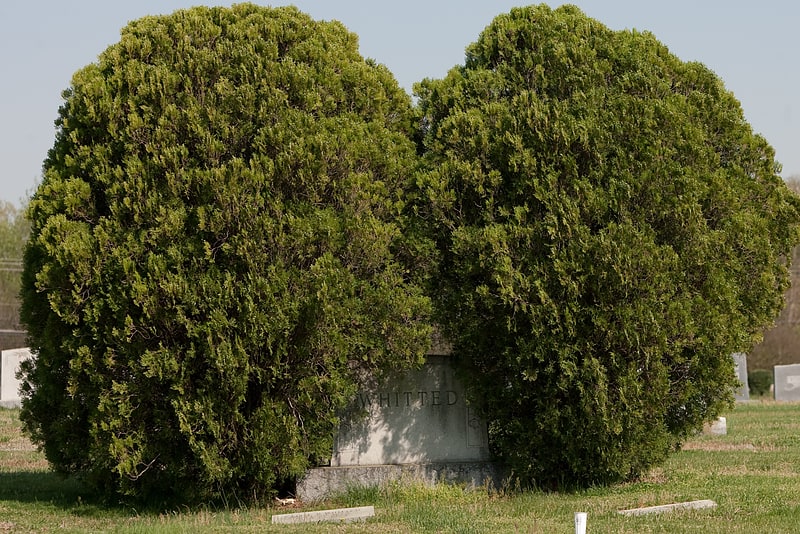
Cemetery in Durham, North Carolina. Beechwood Cemetery is a city-owned cemetery in Durham, North Carolina, established in 1924.[28]
Manbites Dog Theater
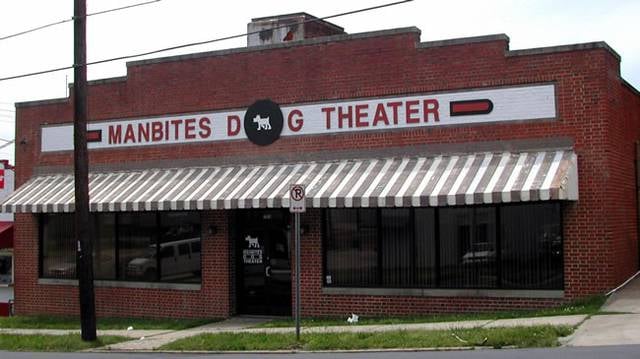
Theater, Concerts and shows, Performing arts
Address: 703 Foster St, 27701-2110 Durham
Durham County Justice Center
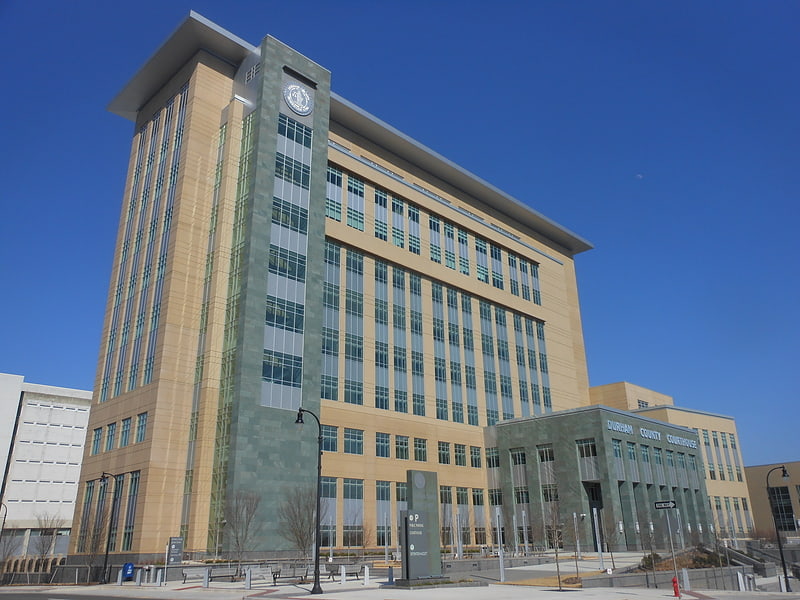
Building. The Durham County Justice Center is a civic building in downtown Durham, North Carolina. The $120 million building opened to the public in February 2013. The building houses the Durham County Sheriff's Office, the Durham County District Attorney's Office, and has 20 courtrooms. The building is 318,533 square feet and was built to LEED Gold Standards. The Justice Center was built with sustainable materials and includes lawns on its roofs for insulation and to capture runoff. It is one of the tallest buildings in Durham and dominates the downtown skyline from NC 147.[29]
Address: 510 South Dillard Street, Durham
West Point Mill
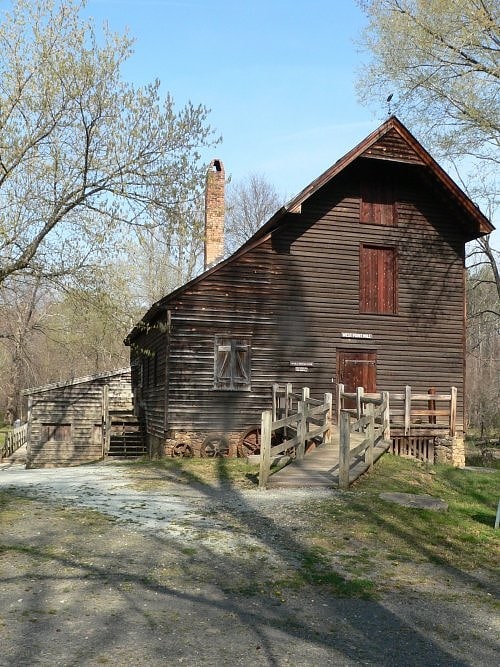
Water mill in Durham, North Carolina. West Point Mill is a reproduction of the historic gristmill on the Eno River in north Durham, North Carolina. The mill and other historic structures are preserved in the West Point on the Eno city park. The mill operates as part of a free tour on weekends, with mill-ground meal and flour available for purchase.[30]
Duke Lemur Center

Research foundation in Durham County, North Carolina. The Duke Lemur Center is an 85-acre sanctuary for rare and endangered strepsirrhine primates, located at Duke University in Durham, North Carolina. It is the largest sanctuary for strepsirrhine primates in the world.
The center is open to the public through tours, for which visitors must make an appointment.[31]
Address: 3705 Erwin Rd, 27705-5031 Durham
St. Joseph's Episcopal Church

St. Joseph's Episcopal Church is a mission of the Episcopal Diocese of North Carolina. The church is located at the corner of Iredell and West Main Streets in Durham, a short distance from Duke University's East Campus.
St. Joseph's began as a Bible study organized by William A. Erwin before the turn of the twentieth century, and became a mission of the Diocese of North Carolina in 1908. Past clergy of St. Joseph's include its first rector, John Shelby Spong (1955 to 1957), who later became bishop of the Episcopal Diocese of Newark. After 50 years as a parish (or self-supporting congregation), St. Joseph's became a mission again in 2006, when the church split over issues of human sexuality. With the support of Bishop Michael Curry, St. Joseph's called a new vicar, Rhonda Lee, in Advent of that year.
Since 2006, the church has enjoyed new life as a small congregation, where laypersons play a vital role in the life of the church. St. Joseph's has strengthened its community ties, celebrating Ash Wednesday, Holy Week, and Easter liturgies jointly with the Episcopal Center at Duke, and answering a new call to ministry with the church's homeless neighbors. St. Joseph's is a member of Durham Congregations in Action, and supports Housing for New Hope and Urban Ministries of Durham.
In May 2008, the church celebrated its centennial and launched its second hundred years with a weekend of worship and fellowship, attended by members and friends from across North Carolina and beyond.
In June 2010, Rhonda Lee left to fulfill a commitment to a Lilly Foundation grant. After a seven-month search, the Rev. Karen Clay Barfield was appointed vicar in February, 2011.[32]
Address: 1902 W Main St, 27705-4838 Durham
Emmanuel AME Church
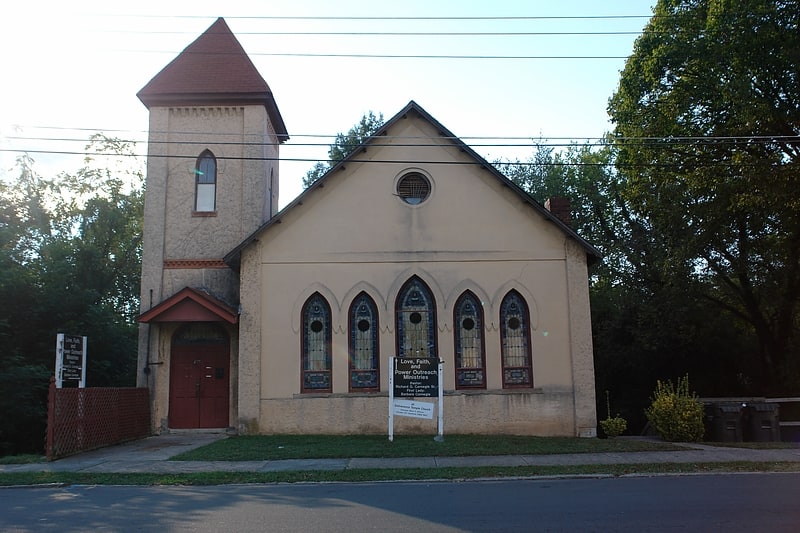
Methodist church in Durham, North Carolina. Emmanuel AME Church, also known as Deliverance Temple Holy Church, is a historic African Methodist Episcopal church building located at 710 Kent Street in Durham, Durham County, North Carolina. The Gothic Revival building was constructed in 1888. The 30 inch walls were covered with stucco in 1962. Both the bricks and land for the church were donated by Richard B. Fitzgerald, a prominent African American brickmaker.
It was added to the National Register of Historic Places in 1985.[33]
St. Joseph's African Methodist Episcopal Church
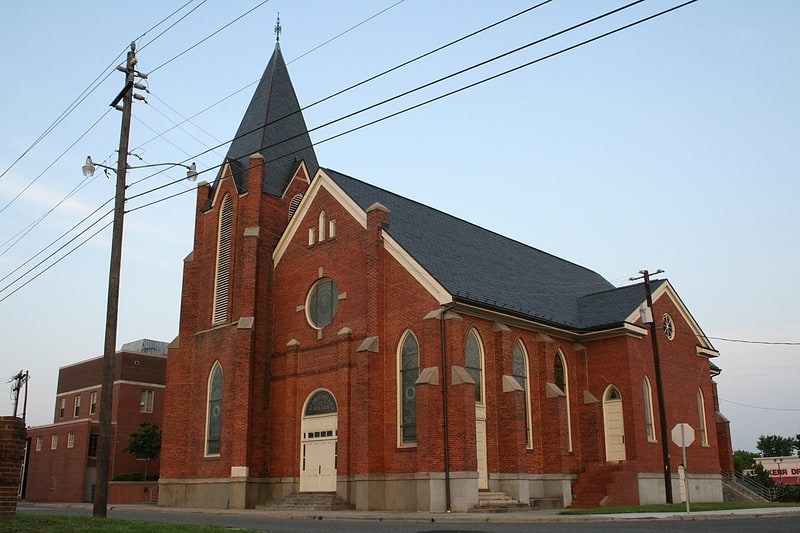
Church in Durham, North Carolina. St. Joseph's African Methodist Episcopal Church is a historic African Methodist Episcopal church building located at Fayetteville Street and Durham Expressway in the Hayti District, now a neighborhood of Durham, Durham County, North Carolina.
Started soon after the American Civil War by black workers, the Hayti District became a well-developed and self-sufficient black community, complete with a variety of businesses and services, including theatre, hospital and hotel.
The church was built in 1891, by a congregation that had organized in 1869, brought together in meetings in a "brush arbor" organized by Edian Markham, a former slave and AME missionary. After building a couple of wooden structures, the congregation raised money for this brick church, including funds donated by white philanthropists.
Edian Markham is buried in Geer Cemetery.
It was added to the National Register of Historic Places in 1976.
It is now used by the St. Joseph Historic Foundation as the Hayti Heritage Centre for cultural and community activities.[34]